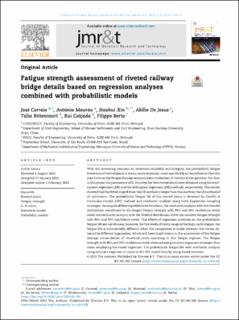| dc.contributor.author | Correia, José | |
| dc.contributor.author | Mourão, António | |
| dc.contributor.author | Xin, Haohui | |
| dc.contributor.author | De Jesus, Abílio | |
| dc.contributor.author | Bittencourt, Túlio | |
| dc.contributor.author | Calçada, Rui | |
| dc.contributor.author | Berto, Filippo | |
| dc.date.accessioned | 2023-09-21T07:44:00Z | |
| dc.date.available | 2023-09-21T07:44:00Z | |
| dc.date.created | 2023-03-31T12:47:55Z | |
| dc.date.issued | 2023 | |
| dc.identifier.citation | Journal of Materials Research and Technology (JMR&T). 2023, 23 3257-3271. | en_US |
| dc.identifier.issn | 2238-7854 | |
| dc.identifier.uri | https://hdl.handle.net/11250/3090999 | |
| dc.description.abstract | With the increasing attention on structural reliability and integrity, the probabilistic fatigue behaviour of riveted joints is drawn more attention, more specifically in the influence that this may have on the fatigue damage accumulation evaluation of structural components. For that, in this paper, the parameters of S–N curves for two riveted joints were obtained using the least-squares regression (LR) and the orthogonal regression (OR) methods, respectively. The results showed that the fitted slope B from the OR method is larger than the one from the LR method of all specimens. The probabilistic fatigue life of the riveted joints is obtained by Castillo & Fernández-Canteli (CFC) method and stochastic analysis using Latin hypercube sampling strategies. Among six different probabilistic functions, the stochastic analysis with the Gumbel distribution contributed to the largest fatigue strength with 95% and 99% confidence levels while the stochastic analysis with the Weibull distribution led to the smallest fatigue strength with 95% and 99% confidence levels. The effects of regression methods on the probabilistic fatigue life are not obvious, however, for the levels of stress range of the high-cycle regime, the fatigue life is substantially different when the comparison is made between the curves obtained by different approaches, which will have implications in the assessment of the fatigue damage accumulation of structural joints operating in this fatigue regimes. The fatigue strength with 95% and 99% confidence levels obtained using constant exponent are larger than when employing the varied exponent. The probabilistic fatigue life with stochastic analysis using constant exponent is closer to the CFC model than by using varied constant. | en_US |
| dc.language.iso | eng | en_US |
| dc.publisher | Elsevier B. V. | en_US |
| dc.rights | Attribution-NonCommercial-NoDerivatives 4.0 Internasjonal | * |
| dc.rights.uri | http://creativecommons.org/licenses/by-nc-nd/4.0/deed.no | * |
| dc.title | Fatigue strength assessment of riveted railway bridge details based on regression analyses combined with probabilistic models | en_US |
| dc.title.alternative | Fatigue strength assessment of riveted railway bridge details based on regression analyses combined with probabilistic models | en_US |
| dc.type | Peer reviewed | en_US |
| dc.type | Journal article | en_US |
| dc.description.version | publishedVersion | en_US |
| dc.source.pagenumber | 3257-3271 | en_US |
| dc.source.volume | 23 | en_US |
| dc.source.journal | Journal of Materials Research and Technology (JMR&T) | en_US |
| dc.identifier.doi | 10.1016/j.jmrt.2023.01.193 | |
| dc.identifier.cristin | 2138859 | |
| cristin.ispublished | true | |
| cristin.fulltext | original | |
| cristin.qualitycode | 1 | |

